ADDITIONAL EXPLANATION OF THE LUHN ALGORITHM IF YOUVE
YOUR COMPANY LOGO HERE (NOTE AN ADDITIONAL FEE090119 107R169 STATEMENTS ABOUT EXISTING CONDITIONS OF UTILITIES ADDITIONAL
10A NCAC 13D 3031 ADDITIONAL REQUIREMENTS FOR SPINAL CORD
12 DELIBERATELY BLANK FOR ADDITIONAL NOTES OLD STATION CLOSE
1998 DISCLOSURE PACKAGE DISCLOSURE OF ADDITIONAL INFORMATION ON ASSET
2 CONFORMED COPY LOAN NUMBER 7664ID LOAN AGREEMENT (ADDITIONAL
Additional Explanation of the Luhn Algorithm
Additional Explanation of the Luhn Algorithm
If you've had trouble following the discussion of the Luhn algorithm in the book, this alternate, lengthier explanation is for you. Big thanks to reader Aaron Mirandon, who reviewed this document and made numerous helpful suggestions.
The Luhn algorithm is used to guard against data entry errors in multidigit numbers for things like product codes. It does so through the creation of a check digit, which is an extra digit that is computed from the digits of the original product code and is appended to the end of product code. Because only one value of the check digit "matches" a particular product code, mistyping digits usually results in a product code that doesn't match its check digit.
There are two related processes: 1. generation of the check digit for the original number, and 2. validation of a number (with check digit appended).
The algorithm is based on the idea that the sum of the digits in the product code should be a multiple of 10. That is, for the first process – picking a check digit – the algorithm will choose a value, that, when appended to the original number, will result in all of the digits equally a multiple of 10. Likewise, in the second process – validation – the algorithm will sum all the digits to see if they are a multiple of 10.
What makes these processes tricky is that every other digit is "doubled." The word "doubled" is in quotes because it's not a strict doubling if the result is a two-digit number. For example, if we "double" the digit 7, instead of simply multiplying 7 by 2 to get 14 and adding 14 into the sum, we instead put the two digits 1 and 4 into the sum. Thus the "doubling" of 7 results in adding 1 and 4, or a total of 5, into the overall sum.
To make the check digit generation process clearer, here's an expansion of the example used in the book. We'll start with the number 176248 and determine the correct check digit.
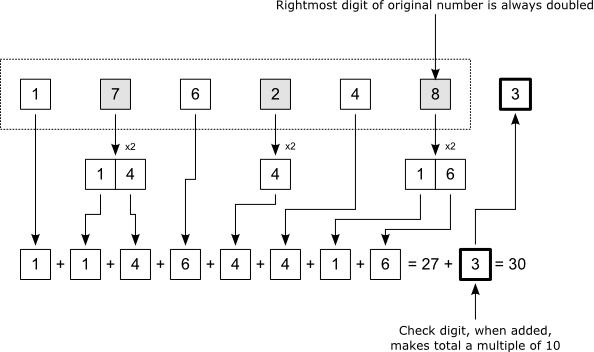
The dotted outline shows the original number. The first thing to note is that every other digit is "doubled," starting with the rightmost digit of the original number and proceeding leftward. In this case, with six digits in the original number, the second, fourth, and sixth digit (shown as shaded boxes) are doubled – the digits with the values 7, 2, and 8. While we determine which digits to double starting with the rightmost digit of the original number, in this case, the 8 of 176248, we don't have to add the digits right-to-left; we can add them in any order. If we know how many digits are in the original number, for example, we'll know which digits have to be doubled.
Remember the rule about doubling the digits. The 7 is doubled to become 1 and 4; the 2 simply becomes 4; the 8 becomes 1 and 6.
All of the digits, doubled or not, are summed to get 27. The only value for the check digit that results in a number that is a multiple of 10 is 3. With a check digit of 3, the sum of the entire number including the check digit is 30.
Here's the validation process on the resulting number, 1762483.
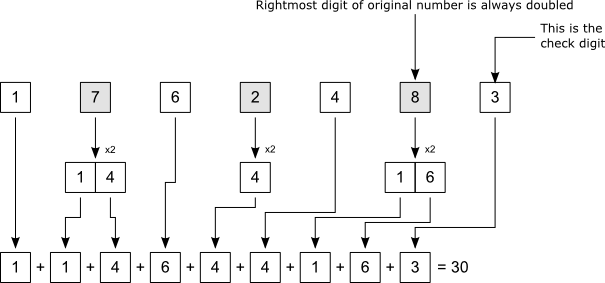
Because this is validation, we assume the rightmost digit of this is a check digit, so it's the second digit from the right that is the rightmost digit of the original number. Therefore it's this digit, the 8, that is the first digit to be doubled. Following the same route as before, except now there's the check digit to be included in the sum. This sum is 30, which is a multiple of 10, so this number, 1762483, is valid.
Here's another example. Our original number here is 34941. Let's generate a check digit:
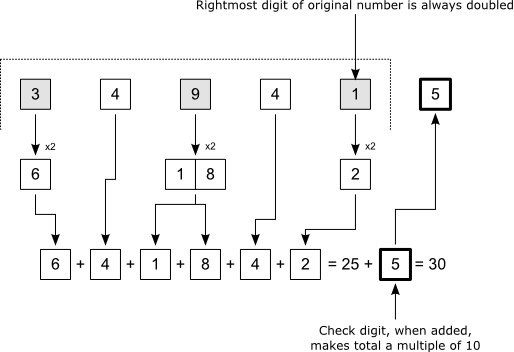
Again, the rightmost digit of the original number, the 1, is doubled, along with every other number proceeding leftward. So the first digit (3), third digit (9), and fifth digit (1) are doubled. Note that the original number in the first example had an even count of digits, so the first digit (leftmost digit) was not doubled. The original number in this case, though, has an odd count of digits, so the first digit is doubled. This is what leads to the problem explained in the book; if we don't know how many digits are in a number, and we are trying to process the digits are they are being read (that is, left-to-right), we won't know which digits are doubled. If we did know how many digits were in the number, we wouldn't have this problem, and mathematically nothing prevents us from processing the digits in any order.
This fact – that to know which digits are doubled, you have to know how many digits there are – is the main source of difficulty in the problem as described in the book. If we allowed the program to read all the digits first – into an array, for example – and only process the digits, we wouldn't have had to go through all the problem-solving steps outlined in the chapter. We would have known how many digits were in the number and therefore would know which digits were doubled and which were not. But because the problem precludes using an array and requires processing the individual digits as they are read, we have to do more work. In effect, we have to process the digits left-to-right even though, to know which digits to double, we have to picture the number right-to-left.
Anyway, in this second example, the sum of the digits in the original number is 25. Therefore 5 is the correct value for the check digit, the value that will make the sum of all digits a multiple of 10. Now let's take the number with its appended check digit of 5, 349415, and validate:
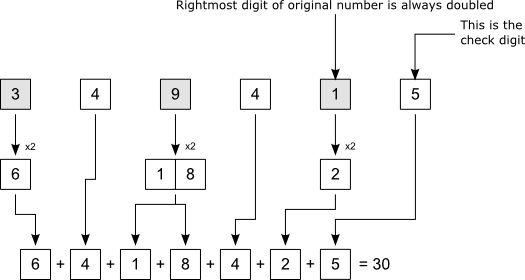
Again, we double every second digit, starting with the rightmost digit of the original number. Summing everything including the check digit, we get a multiple of 30.
Lastly, here's an example of a failed validation. Let's try to validate 95433:
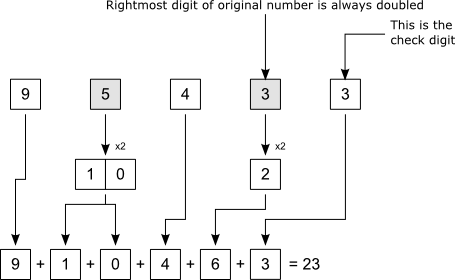
As before, we double every second digit, starting with the rightmost digit of the original number (we assume during validation that the rightmost digit overall is a check digit). In this case, the result is 23, which is not a multiple of 10. This number is therefore invalid.
The Luhn algorithm is good at picking up the kinds of errors commonly made during data entry. If a wrong digit is typed, the checksum will no longer be a multiple of 10 and therefore will fail to validate. Also, if two digits are transposed, like typing 1764283 instead of 1762483, because of the alternate-number doubling, the checksum will again be different. Of course, if multiple mistakes are made, there's a chance they will cancel each other out and the checksum will be valid.
20142015 POST ADDENDUM PEIMS DATA STANDARDS APPENDIX E ADDITIONAL
20180608_additional_sectior_remove_location_manager_v4
214101 §21410—DELEGATION OF AUTHORITY 214121 §21412—FINALITY OF DECISIONS ADDITIONAL
Tags: additional explanation, algorithm, explanation, youve, additional
- MEDWAY COUNCIL LICENSING UNIT GUN WHARF DOCK ROAD CHATHAM
- CICLO TEMAS DE ACTUALIDAD INTERNACIONAL EL CICLO SE PROPONE
- GUIDANCE NOTE TUPE TENDERING COUNCIL CONTRACTS
- PORTARIA Nº 15294 DE 26 DE AGOSTO DE 2021
- CALIFORNIA DEPARTMENT OF EDUCATION CAREER AND COLLEGE TRANSITION DIVISION
- ACTUALIZACIONES PARA LEGISLACIÓN ADMINISTRATIVA (6ª ED 2004) JOSÉ
- PAKIET NR 2 ZAŁ NR 1 ZESTAWIENIE PARAMETRÓW I
- AULA ESAME INGLESE II 22 GENNAIO H 1130
- CENTRAL SECRETARIAT MANUAL OF OFFICE PROCEDURE
- CALWORKS FACT SHEET CONTINUED… CALWORKS PROGRAM FACT SHEET JULY
- NÁZEV PROJEKTU VÝMĚNA ZKUŠENOSTÍ VE STŘEDU MORAVY CÍLE PROJEKTU
- BRAINSTORMING GRID FOR REVIEWING A DANCE PERFORMANCE TO PROVE
- 2021年第30周 境外学者发表的结核病英文文章摘要 (80篇) PUBLICATION DATE 2021071720210723 ((TUBERCULOSIS[TITLEABSTRACT]) AND (ENGLISH[LANGUAGE]))
- SHAPIRO GALLERY EXHIBITION BY ROSWITHA WULFF JULY 18 TO
- LP IMIĘ NAZWISKO RANKING ELO KLUBMIEJSCOWOŚĆ IX
- 1 VAMOS A PRESENTAR LA PROPUESTA DE MODIFICACIÓN DE
- MARIA CURIESKŁODOWSKA UNIVERSITY OCCUPATIONAL SAFETY AND HEALTH &
- ULSTER SQUASH MATCH CARD 20192020 PLEASE REMEMBER A FULL
- 1ST INTERNATIONAL YOUTH TOURNAMENT ITF IN ZAGREB Z A
- MARINE STEWARDSHIP COUNCIL LINE 2 LINE 3 MSC NOTICE
- FICHA TÉCNICA 1 NOMBRE DEL MEDICAMENTO PERFALGAN 10 MGML
- INTRODUCEREA ŞI EXECUŢIA ORDINELOR DE BURSĂ ÎN SISTEMUL DE
- FAMOUS AMERICANS POWERPOINT SLIDES THESE SLIDES MUST BE A
- Microscope Slides our Microscope Slides are Available in Standard
- CORRIGÉ SYNTHÈSE LA FÊTE ET LE RAPPORT
- SCREENING OF YEASTS IN VITRO TO BIOCONTROL ASPERGILLUS CARBONARIUS
- CHAPTER 15 ANSWERS 1 THE RESULTS ARE AS
- DYNAMIKA 1 SIŁA MA WARTOŚĆ 1 NIUTONA GDY A
- NCEA LEVEL 3 BUSINESS STUDIES (91380) 2013 — PAGE
- MACHINE READABLE ARTIFACTS FOR OMG SUBMISSIONS THIS DOCUMENT PROVIDES
UNIVERSITY OF DUBLIN TRINITY COLLEGE REQUEST FOR PERMISSION
FORMATO DE TEXTO TIPOGRAFÍA CSS DEFINE NUMEROSAS PROPIEDADES PARA
LØNNSAKEN KRONOLOGI – MØTER I SKOLESTYRET 1951 1966
ANNEXE 1 MODÈLE DE PROPOSITION DE PROJET DU
 SENIOR CONSTRUCTION ENGINEER PAGE 4 SENIOR CONSTRUCTION ENGINEER FC
SENIOR CONSTRUCTION ENGINEER PAGE 4 SENIOR CONSTRUCTION ENGINEER FCSAISTOŠIE NOTEIKUMI 2003GADA 29DECEMBRĪ SIGULDĀ NR1 (PROTNR16 16§) PAR
 T EKLIF HAZIRLAMA SORU LISTESI GENEL BILGILER FAKS YOLU
T EKLIF HAZIRLAMA SORU LISTESI GENEL BILGILER FAKS YOLU CRNA GORA OPŠTINA ANDRIJEVICA PRIJAVNI OBRAZAC NAZIV SPORTSKE ORGANIZACIJE
CRNA GORA OPŠTINA ANDRIJEVICA PRIJAVNI OBRAZAC NAZIV SPORTSKE ORGANIZACIJE G ENÇLİK KOLLARI AKRAN EĞİTİMİ PROJE GRUBU SONUÇ RAPORU
G ENÇLİK KOLLARI AKRAN EĞİTİMİ PROJE GRUBU SONUÇ RAPORU DECLARACIÓN DE LOS DERECHOS DEL NIÑO APROBADA POR LA
DECLARACIÓN DE LOS DERECHOS DEL NIÑO APROBADA POR LATAXABLE ITEMS WAGES SALARIES AND OTHER COMPENSATION
 CIRUGIA DEL SENO MAXILAR OD CAMPAGNALE RAMIRO (ESPECIALISTA EN
CIRUGIA DEL SENO MAXILAR OD CAMPAGNALE RAMIRO (ESPECIALISTA ENKENDRIYA VIDYALAYA NO 3 AFS BHISIANA COMMITTEES FOR THE
FELNŐTTKÉPZÉSI NYILVÁNTARTÁSI SZÁM 007612009 FELNŐTTKÉPZÉSI TÁJÉKOZTATÓ ADITUS ZRT KÉPZÉSI
 TEMAT MOI RODZICE I „DUŻY I MAŁY SKOK” TO
TEMAT MOI RODZICE I „DUŻY I MAŁY SKOK” TO PASIÓN Y DESEO EN LA RESISTENCIA A LA DICTADURA
PASIÓN Y DESEO EN LA RESISTENCIA A LA DICTADURA INFORMACIÓN PARA LA ELABORACION DE ESTUDIOS DE IMPACTO AMBIENTAL
INFORMACIÓN PARA LA ELABORACION DE ESTUDIOS DE IMPACTO AMBIENTAL7 LA COMEDIA DEL ARTE SEMIÓTICA DE LA ESCENA
TEXAS COMMISSION ON LAW ENFORCEMENT 6330 E HIGHWAY
GENERELT EKSEMPEL PÅ EN KLAGE NEDENSTÅENDE ER ET